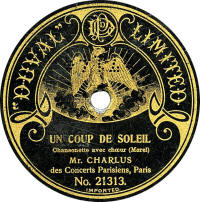In March 1912, 12" Dacapo records costing 4/- were announced.
The prices were reduced in the autumn of 1912, mainly due to a price war triggered by Lindstrom's introduction of Coliseum & Scala records at 1/6. Dacapo records were then priced at 2/- for 10" records and 3/- for the 12" ones.
In 1913, the company became part of the Carl Lindstrom group, but the manufacture of Dacapo records was never switched to Britain; all Dacapo records were made in Germany. Sales of Dacapo records to Britain ceased on the outbreak of WWI with some later issues (presumbly residual stock) having the place of origin (Berlin) expunged from the label.
Most British Dacapo issues were Dacapo original recordings, though it would appear masters from other German record companies were sometimes used and given Dacapo master or control numbers.
Thanks to Bill Dean-Myatt for the label scan, showing the design for the 12" records.
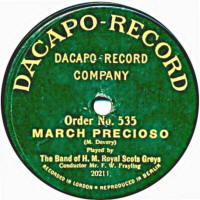
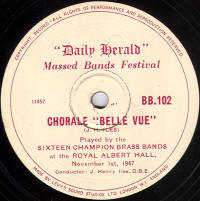
The records were in both 10" and 12" sizes and were recorded by Master Sound Systems (MSS), using their "ffidelitone" system and also by Gui de Buire (and probably others). There were a number of designs and colours and series, usually depending on the type of dance on the record. Many had a strobe around the edge of the label to ensure the correct tempo when played.
In 1951, the price of records is known to be 5/- for the 10" records.
Thanks to Bill Dean-Myatt for the label images.
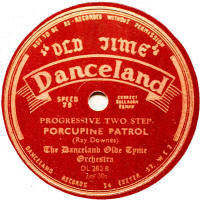
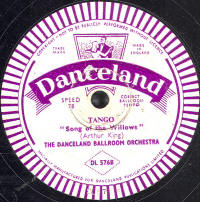
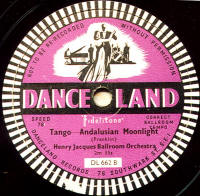
The record catalogue started at D-1 for the 45s and SED-1 for the 78s (SED = Seventy Eight Dandy!) with the same recordings in both series where the number matched. There was also a DB-series which came with a booklet, tthough I believe these were only available as 45rpm records. The highest SED I've seen is SED-16, though the 45rpm issues ran at least unil D-43.
Thanks to Richard Prout for the label image.
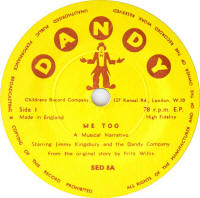
Dabycord has puzzled collectors for a number of years, but it is now known this was started by William Sinkler Darby.
Darby was born in 1878 in South Carolina, USA. From 1895 he was an assistant to Emile Berliner in the early development of disc recording. In 1899 he came to England and worked in the research & recording dapartment for The Gramophone Company for over 20 years, working closely and travelling extensively with Fred Gaisberg to take new recordings.
In late 1921 or early 1922 it was reported in the Canadian press that he had set up his own recording studio, and this was Darbycord; he had applied for the name in November 1920 and it was registered as a trade mark in April 1921. These recordings enabled singers to improve their technique by hearing themselves.
Although the two examples here date from 1922, there must have been many others and we don't know how long the business continued.
I also don't know who pressed up these records, or what they are made from as I've not been able to examine any "in person".
In 1924, Darby returned to the US, to set up new recording rooms for Brunswick Records in California and he subsequently became technical manager of the recording & research department for the American Brunswick company.He continued to travel regularly between the US and UK, eventually setting up British Brunswick in 1926, and in 1928 moved to Duophone.
William Sinkler Darby died in 1950, in Baltimore, Maryland, USA.
Thanks to Bill Dean-Myatt for the first label image, and to Richard Prout for the second.

Note regarding master numebers: GA/GB- series were recorded at the Chenil Galleries, TA/TB-series at Upper Thames Street, DR-series were a continuation of the Rex label R- series foillowing Decca's takeover of Crystalate in 1937.
Initially, there were two disctinct series: the standard series with blue labels had F- prefixes for 10", starting at 1500. The label design changed little over the years until the mid-1950s when the silver-on-blue design shown here appeared with the famous "ffrr" ear logo. The equivalent 12" series had a K- prefix, but the labels were brown initially, before changing to blue like the 10" and later red.
The more expensive series was fairly short-lived: the M- series (Magenta) for 10" and the T- series for the 12" with the same design. Later M-series issues had a rec label (see examples).
For classical music there were a number of series & colours all linked to Decca's agreement with the German Polydor company.
Full listings of the various Decca series have been published by the CLPGS.
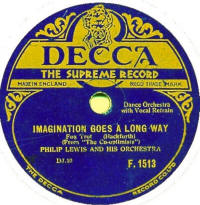
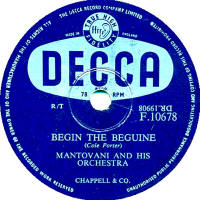
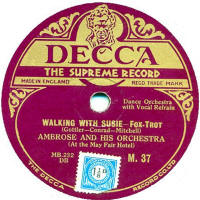

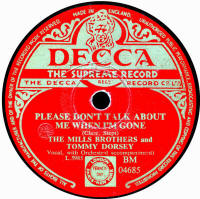
(courtesy
Bill Dean-Myatt)
Thanks to Bill Dean-Myatt for the label image.

From the known details, the masters are from ARC (American Record Company), but others could be from any source that the former Disc Record Comapny had access to.
The first image shown here is a composite, based on a rather poor monochrome copy and a description of the colours. It has been cleaned up, thanks to some excellent and painstaking work by Norman Field & Steve Walker, but can only be a guide until an actual record turns up.
Finally, courtesy of John Culley, we have a good image from the actual record, probably the same one as above. You can see that it isn't quite as colourful as imagined!
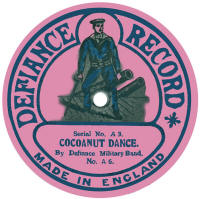

Thanks to Bill Dean-Myatt for the label image.
Thanks to Bill Dean-Myatt for the label image.
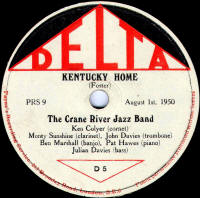
Thanks to Bill Dean-Myatt for the label image.

Please e-mail me with details of ANY of these records.
Thanks to Chris McDonald for the label image.
This came from Australia, and it may be that the reason we don't see them in Britain is because they were all sent to Australia!
Note that there is no catalogue number, nor copyright stamp on this record.
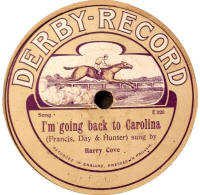
Then there was a 10½" vertical cut disc produced by Pathe from 1915 for the Diamond Disc Record Company Ltd of 81 City Road London. Like Pathe records of the period, it initially had no paper label, but the details were etched in light blue in the label area (see 2nd image). Unlike Pathes it was an "ouside start" record. They were cheap at 1/6 each. In 1916, Pathe took over completely and for the next few years the record had paper labels until it's demise in about 1918.
There may well be a third label, dating to the pre-1920 period, but only a sketch for the design has ever been seen, and it is very similar to the first one above so may just be a prototype design for it. This desogn was submitted for registration by The Beka record Co in 1912.
Thanks to Bill Dean-Myatt for providing the label photos.

(Flexible picture disc)
Please e-mail me with details of ANY of these records.
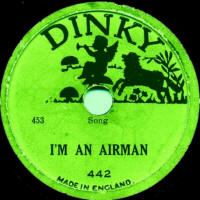
For about the first year Diploma records were made by Edison Bell using their existing matrices from Bell & Velvet Face discs.
In the summer of 1912, Blum entered into a contract with Kalliope Company in Saxony, Germany, to provide recordings & press records, some of which were recorded by Blum in their Old Street, London, studios. It is understood that this was an exclusive agreement, but when Blum found out that Kalliope was using his (Blum's) masters to press records for other clients, he terminated the agreement and found another German manufacturer, currently not identified, to press records. The labels then state "Made in Prussia", so it could be that Lindström was the company making these records.
Following the outbreak of WWI, Blum had to find a British manufacturer and the later Diploma records were made in Britian by the Disc Record Company, of Harrow, sometime usein new exclusive recordings made by the DRC. Both Blum and the DRC went out of business in the spring of 1915.
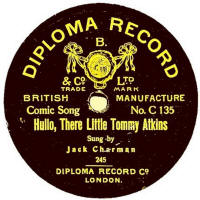
The recordings were made by Regent Sound of Denmark Street, London.
Thanks to Bill Dean-Myatt for the frist image; the second is from "For The Record" No. 44, and I've included it as it has a coloured background, though I don't know if the one Bill supplied was from a monochrome image anyway!
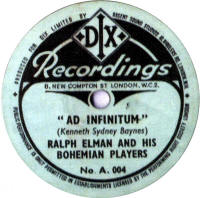
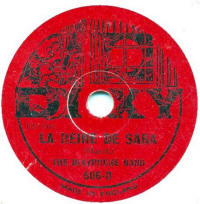
Thanks to Bill Dean-Myatt for providing the label image.
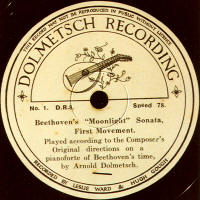
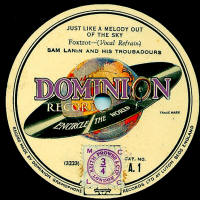
They date from the late 1950s or even the early 1960s. The label continued (still made by Decca) into the 45rpm era.
The catalogue number started at VPN 100 or 101, but by VPN-115 they were available as 45rpm issues.
Thanks to Bill Dean-Myatt for providing the label image.
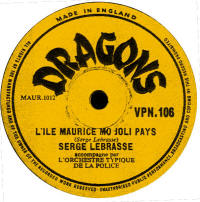
The Dreadnought over-label shows no catalogue number (it is pasted over Coliseum 163), so this was not an attempt at a regular catalogue, but there must surely have been other examples, as the label is properly printed and designed. If you shoudl find any, do let me know & send me images if possible!
Label images courtesy of Paul Buck, from the collection of David Moore.
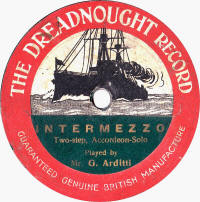
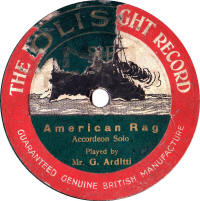
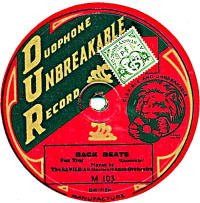
In the 1950s there was another Durium label, made in England, which contained Italian music recorded by Durium of Italy (see second image - thanks to Bill Dean-Myatt for this image).

Even Frank Andrews in Hillandale News No. 209 admits to knowing next to nothing about the Duval disc records: when they were produced, by whom, where they were sold and for how long. The fact that some of the text is in English (including the word "imported" at the foot of the label) implies they may well have been sold in Britain. The company was wound up in 1909.
Thanks to Fred Finnigan for the label image.
